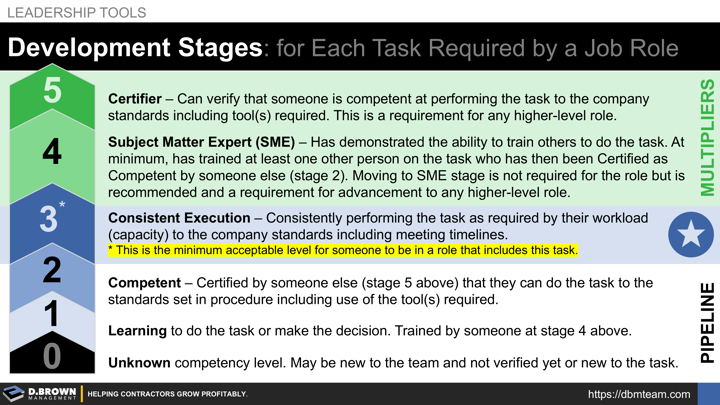If you don't have something like this in place already, you can start quickly — regardless of your stage of growth, job descriptions, or standards.
- Look at your org chart — even if it is just a sketch on a whiteboard. Don’t focus on everyone at once; it’s best to tackle just a few job roles and no more than 8–10 people in a single working session.
- For each job role, what are the Top 10 tasks that have the biggest impact on outcomes — the leading activities? Again, this doesn’t have to be perfect on the first pass; just create a prioritized list, time-boxing the first draft to 30 minutes per job role. They may already be in the job role descriptions or may just be implied. This can start on a whiteboard or notepad but moving them to a spreadsheet will be necessary.
- For each person in the role, and for each task, evaluate them on the 0-5 development stage scale — see below. Where applicable, go look at their work product and measurable outcomes for the task.
- For each person, what is one specific action that can be taken over the next four weeks that will move their development forward? Think about this in the context of the individual, the whole team, the manager, and the work they have in front of them. You may be able to develop multiple people at once if there are common improvements.
There are more nuances to this, but these are the basics. Like an exercise routine, the first few workouts are the hardest, especially prioritizing the most impactful tasks and development actions. Sitting down with the people in those roles and working through it with them the first few times is also very challenging, as it can feel like judgment.
Please reach out at any time to talk through how to normalize the feedback loop and continuous improvement with your team. We will freely share all the lessons we've learned working across teams at all stages of growth.
Development Stages for Each Task
0 - Unknown competency level. May be new to the team and not verified yet or new to the task.
1 - Learning to do the task or make the decision. Trained by someone at stage 4 below.
2 - Competent – Certified by someone else (stage 5 below) that they can do the task to the standards set in procedure, including use of the tool(s) required.
3 - Consistent Execution – Consistently performing the task as required by their workload (capacity) to the company standards including meeting timelines. ***This is the minimum acceptable level for someone to be in a role that includes this task.***
4 - Subject Matter Expert (SME) – Has demonstrated the ability to train others to do the task. At minimum, has trained at least one other person on the task who has then been Certified as Competent by someone else (stage 2). Moving to SME stage is not required for the role but is recommended and a requirement for advancement to any higher-level role.
5 - Certifier – Can verify that someone is competent at performing the task to the company standards, including tool(s) required. This is a requirement for any higher-level role.
With this, you can quantify where someone is at. Quantification isn't everything but it can be a helpful tool for seeing where you are at, and what progress you are making.
Total an individual’s score, with a maximum of 3 points for each of their Top 10 Tasks — for a maximum possible score of 30 points (3 × 10). Divide their current score by 30 to get a percentage you can track over time.
Look at everyone in the role together and you can get a picture of where that whole part of the organization is at.
As an example, we worked with a client whose project team had grown rapidly and was under stress — overloaded with work. The challenges seemed two-fold: the business model didn’t pencil out if more people were hired to reduce workload, and there weren’t enough experienced people performing at stages 4 or 5 to accelerate development (multipliers).
Quantifying the team's overall development stage, they were at about 75% and interestingly, this made the basic math work on their business model.
It was evaluated that everyone on the team had the right values for the team, the aptitudes and the desire. The first 1:1 meetings had all the normal challenges with feelings of judgement, not enough training, etc.
The development action items were focused first on the people and tasks that could get to stages 4 (train others) and 5 (certify others) the fastest. That included people directly on the project teams and others from across the organization who had experience.
This prioritization then accelerated the development actions for others moving them more quickly into stage 3 or above for tasks.
Because of the intentionality of the evaluation, training, and certification, it also forced a lot of improvements to standards, including how well they integrated with each other, simplification, and consistency of tools used.
Within a year, the team was performing close to 90% with stress levels dropping despite having even more volume than the prior season. Time to add more people to the team and continue the growth...
Once standards and feedback become normalized on a team, both growth and joy at work accelerate.

